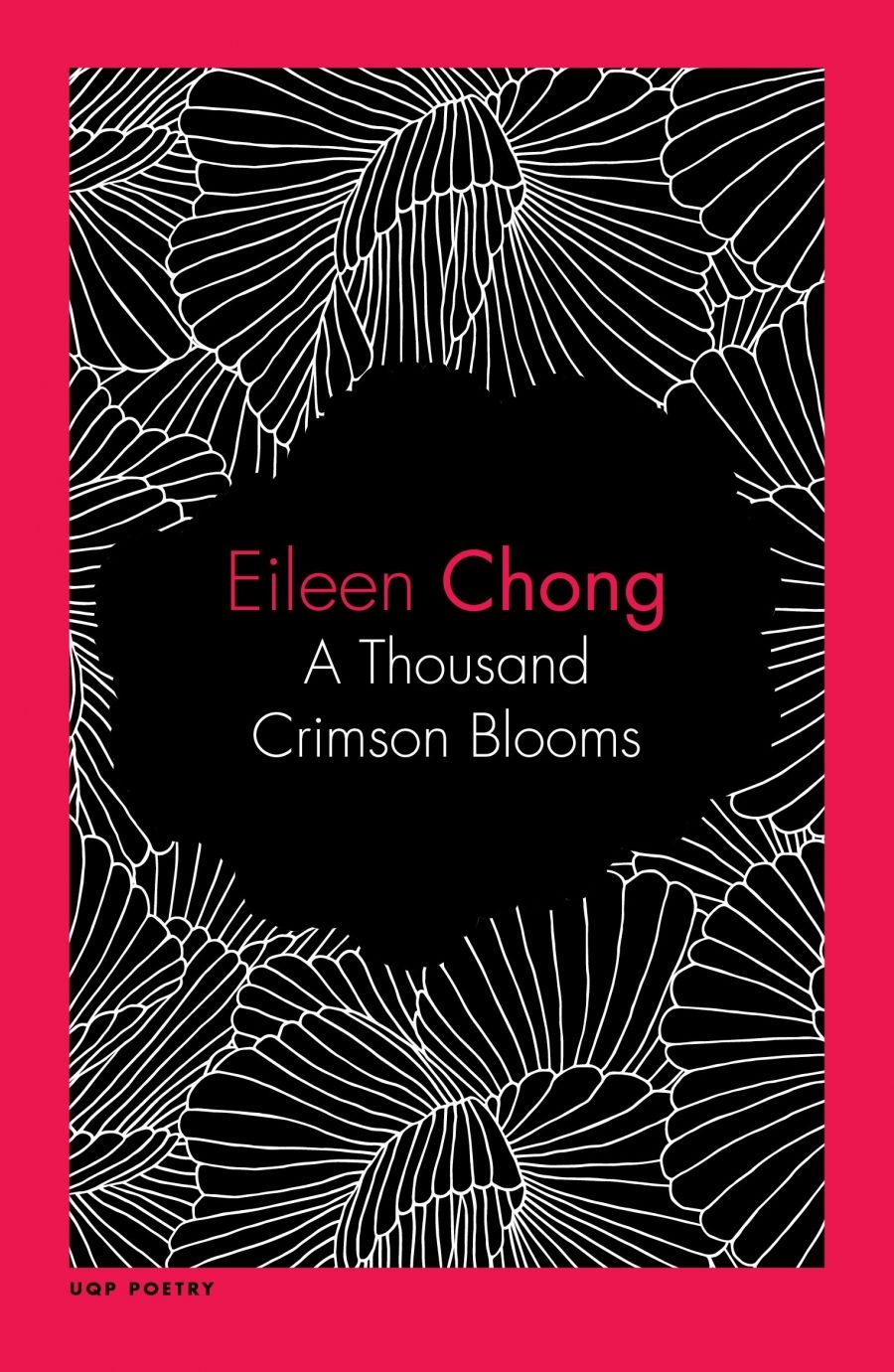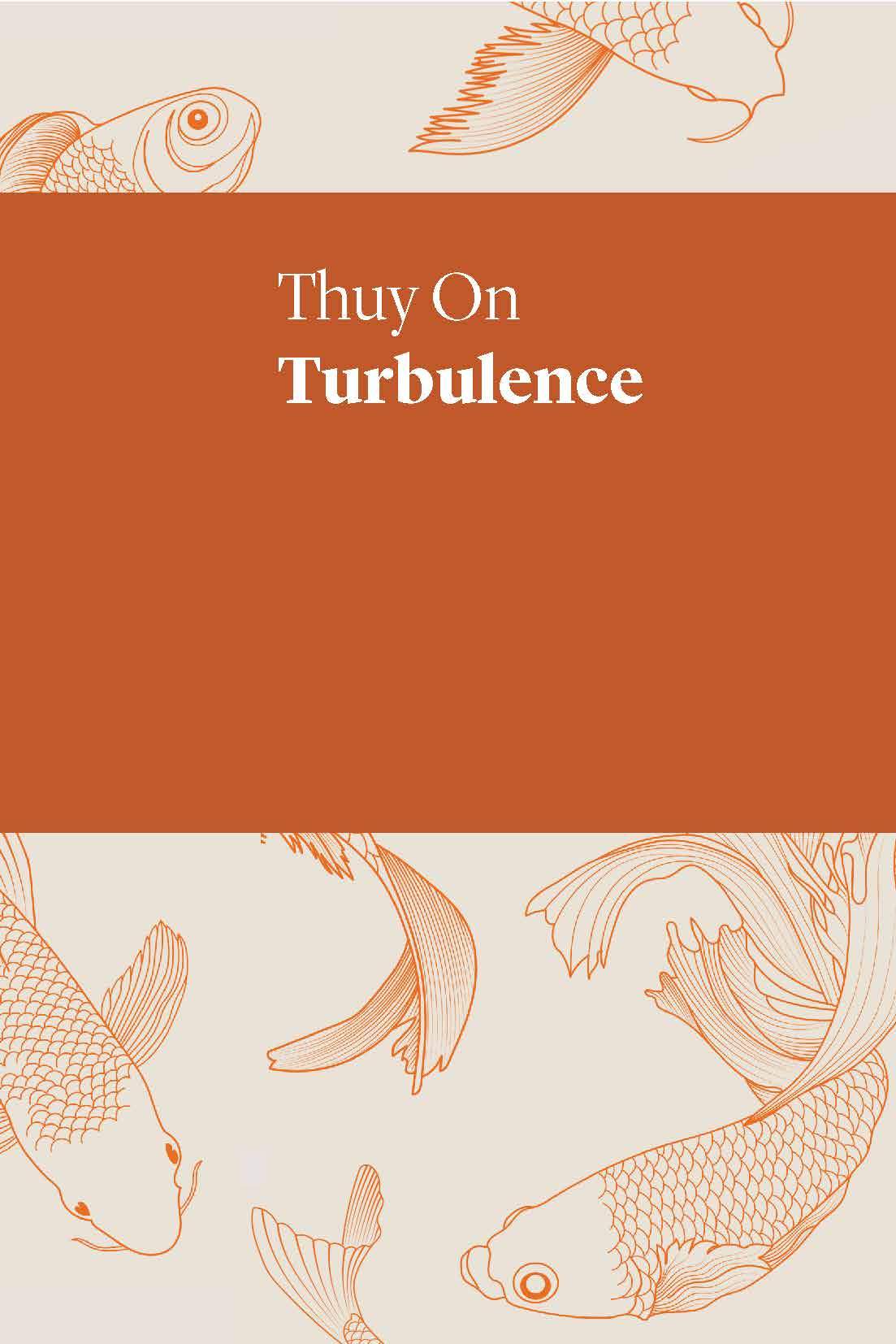
- Free Article: No
- Contents Category: Poetry
- Review Article: Yes
- Article Title: Merit in quietude
- Article Subtitle: Two new poetry collections by Eileen Chong and Thuy On
- Online Only: No
- Custom Highlight Text:
The biographical note to A Thousand Crimson Blooms observes that Eileen Chong’s first book, Burning Rice (2012), is ‘the first single-author collection of poetry by an Asian-Australian to be studied as part of the NSW HSC English syllabus’. Having run many writing workshops for students and adults over the years, Chong takes her pedagogy as seriously as her poetry. It’s no surprise, then, that A Thousand Crimson Blooms, Chong’s fifth collection, is replete with scenes of instruction. In ‘Teacher’, the poet corrects her mother’s pronunciation (‘I say TEAcher, then, I say teacher. / … I feel like an arsehole’) only to stand corrected by memories of her mother’s gentler tutelage. The collection’s dedicatee, Chong’s grandmother, metes out corporal punishment in ‘Hunger’, but has her own body disciplined in ‘Float’. The poet learns the meaning of ‘thole’ (Scottish for ‘to endure / what is barely bearable’) and after surgery discloses the origins of her nurse’s name. If there is pathos evoked by these anecdotes, much of it has to do with the way knowledge – how to care for the body, where to look for the roots of words – helps the poet overcome the inertia occasioned by violence, whether racial, sexual, or medical.
- Book 1 Title: A Thousand Crimson Blooms
- Book 1 Biblio: University of Queensland Press, $24.99 pb, 86 pp
- Book 2 Title: Turbulence
- Book 2 Biblio: UWA Publishing, $22.99 pb, 150 pp
- Book 2 Cover Small (400 x 600):

- Book 2 Cover (800 x 1200):

- Book 2 Cover Path (no longer required): images/1_SocialMedia/2021/June_2021/Turbulence.jpg
There is a pristine plainness about Chong’s characteristic idiom that rises in certain poems to the consciously attenuated lyricism of Classical Chinese:
The moon rises above clouds.
In the cold light, all is grey, and white.Night sky turns on a paper wheel.
Stars are silvered, immutable.The only sound: a deer scarer
filling, emptying, and filling again.
Imagist pastiche tends to lurk at the edges of such feats of stylistic translation; there is always the danger that attempts to capture the 淡 (dan, ‘light’ or ‘lacking in flavour’) – the sense of being at the ‘undifferentiated foundation of things’ (in the words of François Jullien) – that infuses both Taoist and Confucian strands of Chinese aesthetics might simply result in blandness. However, the discreet dynamism of Chong’s verse, where each couplet holds one line’s disposition towards movement in tension with the other line’s insistence on stasis, manages to capture the elusive feeling of incipience associated with 淡.
Yet Chong’s bareness of statement also risks exposing some of the poems’ conclusions as a little pat. For instance, in the last line of ‘Teacher’, the revelatory self-awareness of ‘I am adding up to a whole’ seems a bit too precipitate (though the reasons for the assertion of ‘wholeness’ are overdetermined: the leg missing from her mother’s painted stag, the pun on ‘arsehole’). In ‘Paper Boats’, the final observations – ‘Words are heavy. Paper boats sink’ – don’t quite rise to the trenchancy of aphorism. The beautiful ‘Furrow’ might have ended hauntingly with the image of the ‘hung skulls’ listening in on the poet’s singing; instead, there is a flat gloss (‘No-one / loses anything. We all leave so we can come home’) of the epigraph from Ecclesiastes (‘unto the place from whence the rivers come, thither they return again’). The self-glossing is there in other poems, especially those that parse Chinese ideograms, but here Chong seems to indulge her pedagogic impulse, spoonfeeding the reader as if they were a recalcitrant student on the verge of failing their English exams.
A Thousand Crimson Blooms is written by a poet whose capacity for eloquence might seem to stem from her intimacy with suffering. ‘It’s not rocket science: what goes in, / comes out’, as Chong puts it in ‘The Numbers Game’, one of the poems in ‘The Hymen Diaries’ that deals with the toll of IVF treatment with dignity and directness. The bane of poetry written by diasporic and women writers (two of our designated ‘sufferers-in-chief’), this naïvely expressivist approach tends to narrow the emotional and imaginative range of work like Chong’s, which admittedly has no shortage of ‘heavy’ themes. Even when tuned into a more sombre key, the recognisably surrealist juxtapositions of ‘Maria-Marcè in the Palm Grove’ or the title poem contain an element of play that should remind readers a little of Burned Rice’s whimsical, picaresque ‘After Pintauro’.
‘There is merit // in quietude, in the precise layering of sound, / image, and object,’ Chong notes in ‘Turning the Bend’, something of a mature ars poetica. Not just ‘quietude’, then, but the ‘quietude’ that comes with conscientious workmanship. Fittingly, A Thousand Crimson Blooms features one of the finest georgic poems I’ve read recently, ‘Content’:
These days, there are metal tools,
sweat, and our tirelesshands. Moving to make room
for the other, the giving up of dead
things, taking into our selves only
what we’ve earned, and what is sweet.
Eileen Chong’s blooms are the sweet fruits of a bitter harvest.
Where A Thousand Crimson Blooms bears residues of the poet’s work as a teacher, Turbulence is the first book of verse by a seasoned journalist, critic, and editor. The voice that emerges from these poems is cosmopolitan and suave, projecting a familiarity with the arts onto the more precarious intimacies of the poet’s romantic life. These are love poems born out of vicarious enjoyment and a fascination with others’ fascinations (‘a loop unbroken / your transfixion / my absorption’) – characteristics that are difficult not to attribute to Thuy On’s career as a Melbourne theatre critic (and it is a very ‘Melbourne’ collection insofar as the ritual of seduction tends to unfold in and around the consumption of culture). There is sensuality, but also a will to abstract – to draw out from and objectify lovers and their moments of rapt attention – that reverses the circuit of wish fulfilment in the Pygmalion myth that hovers over these poems.
Like Chong’s, On’s style is characterised by a degree of terseness. As she recently noted in an interview, what criticism and poetry share is a ‘rigour and discipline’ in the sparing use of words: ‘you have to be sure that every word is pulling its weight: no extraneous indulgence’. This ethic is at work at all levels of the book’s construction, from the brevity of the lines to the concision of a contents page comprised mostly of single-word titles (‘Agape’, ‘Bello’, ‘Koi’, ‘Postmodernism’, ‘Syntax’, ‘Vantage’). It’s as if Turbulence were a compendium of conceits with each poem a flashpoint of recognition and desire too volatile to be accommodated to any conventional plotline.
But against the grain of this minimalist self-styling is a maximalist aspiration in On’s fecund image- and phrase-making. The laying on of trope after trope gives a poem such as ‘See-saw’ an almost metaphysical or baroque density:
… there’s no antidote
just time’s slow crawl
and this see-saw need
to recall
months of fitful joy
when in tune
a pas de deux
we gleaned in a bubble
lightweight
untouched
from the creases of the world.
There is a restless, ‘fitful’ intelligence at play here in a pattern of images that just about hangs together by virtue of the unpredictability of the enjambment and the delicate aural stitchwork (the threading of ‘crawl’ through ‘see-saw’ and then ‘recall’). At times, however, the predilection for compact phrasing does result in a pile-up of appositives that is little more than a gratuitous revving of the poet’s rhetorical engine (‘slick stiff hair / crow-gloss / a fine-featured boss / culture vulture’). Similarly, the moving and otherwise deftly handled elegy for Eurydice Dixon (‘Vale Eurydice’) is marred a little by an obtrusive desire for immediacy in the lines:
wan in the squall
warmth in congregation
an open plain
a shedding of flowers
prostrate shaking
saying your name ...
But the poem manages to wrest back its eloquence from such spasmodic denotation by aligning itself into a syntax that heightens rather than diminishes the parenthetical break at ‘twig’:
… means wide justice
but now once again
shadows will be jumped
twig break a warning
the sky on the crack
of becoming a bruise.
In being literalised, ‘crack’ is purged of the banality of another false dawn. And just as Dixon’s mythical namesake was plunged back into the underworld, we are, by the end of the poem, sunk in a world eclipsed by the threat of gendered violence.
Many of the poems in Turbulence are marked by a writerly self-awareness exacerbated by the textual tawdriness of the poet’s experiences on online dating platforms. These are travestied with élan (‘Tinder-burnt, Bumble-fumble and Ok-stupid’) in the third and longest of the collection’s four sections. In poems such as ‘Freelancer’ and ‘Dating as slush pile’, On draws suggestive analogies between the gatekeeping that goes on in the literary and sexual marketplaces. But the recurring conceit whereby typographical elements or grammatical categories become metaphors for romantic attachment wears a little thin by the time we arrive at ‘Ligature’, the section’s last poem.
Despite the welter of indignities, On hangs on to her sense of self-worth, as precious as an ‘ermine cloak’. This is a telling image that points to the lordly demeanour that deigns to transfigure the poet’s vaudevillian encounters with a host of ‘bumbling knaves’. Such is the governing tone of ‘Repair’, a poem almost Yeatsian in the coolness of its self-command and refusal of pity:
There is an air-releasing valve
that for this ventricular repair
a master craftsman must attend
to stitch and staunch the flow
On the strength of this performance, one gets the feeling that this ‘master craftsman’ is less likely a suitor than the poet herself.


Comments powered by CComment